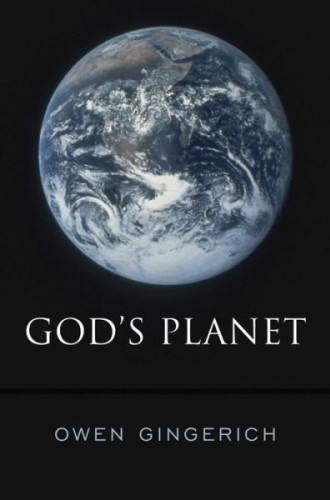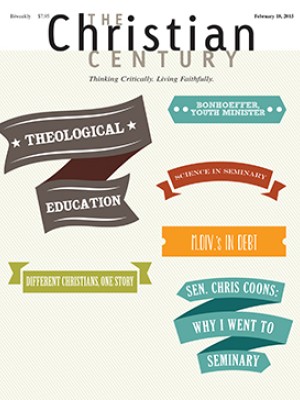God’s Planet, by Owen Gingerich
How is one to understand the relationship between science and religion? “New atheists,” such as Richard Dawkins, have a ready answer: they are in conflict. Either one accepts the Bible’s account of a six-day creation and Adam and Eve, or one adopts a scientific worldview incorporating the Big Bang theory and evolution. There is no middle ground; the two are incompatible, and one has to make a choice.
This is a simplistic viewpoint. It doesn’t take into account the many scientists who have no difficulty accepting the findings of science and yet subscribe to a theistic belief system. The evolutionary biologist Stephen Jay Gould proposed an alternative. He regarded science and religion as addressing different kinds of questions. Science is concerned with uncovering how the world operates, while religion is concerned with broader questions having to do with purpose and overall meaning. Each has its own domain of competence. There need be no conflict, providing that religion and science stick to their own territory. This viewpoint is known as nonoverlapping magisteria.
Read our latest issue or browse back issues.
In his short, punchy, accessible, and thought-provoking book God’s Planet, Owen Gingerich goes a step farther with a more nuanced approach. As emeritus professor of astronomy and the history of science at the Harvard-Smithsonian Center for Astrophysics, he is well qualified to address the issue. He agrees with Gould that the two disciplines address different kinds of questions and that we need both discourses to gain a fuller understanding of what is going on. But are science and religion really as independent of each other as Gould would have us believe? Gingerich says no. Not only can scientific discoveries affect religious beliefs, one’s religious mind-set can mold how one receives and interprets scientific developments.
What sets this book apart from others dealing with the science-religion debate is that rather than dealing in generalities, the author illustrates his viewpoint by focusing on three case studies related to the work of three scientists, Nicolaus Copernicus, Charles Darwin, and Fred Hoyle. The introduction of personal details concerning these thinkers makes what is already an easy read even more enjoyable and engaging.
Today it strikes us as obvious that the earth goes around the sun rather than the reverse. So why did it take a century and a half for Copernicus’s ideas, set out in On the Revolutions of the Heavenly Spheres, to gain universal acceptance? Was Arthur Koestler right in claiming that virtually nobody read that daunting 400-page tome? Gingerich has uncovered persuasive evidence that this was not the case. Copernicus’s book was well read by fellow scholars.
So why the delay in embracing Copernicus’s views? Partly it was because some of the evidence in favor of a heliocentric universe was not yet on hand. But more important was the religious mind-set of the time, which was rooted in a literal interpretation of the Bible. One thinks, for example, of the declaration in Psalm 104 that “the Lord God fixed the Earth on its foundation so that it can never be moved.”
Furthermore, there was in place at that time a very neat understanding of the cosmos: the earth was at the center, the sun and planets revolved around it in their respective orbits, then the stars, and beyond them the heavenly realm, and finally on the outside, God’s arms holding all in place. It was an aesthetically pleasing picture that many were reluctant to relinquish. Thus we have an example of how religious thinking can affect scientific progress.
We see the same forces at work in Gingerich’s second example, Darwin’s theory of evolution by natural selection. Many churchgoing people in the United States do not accept the theory. This seems to be due to a number of reasons: an inability to reconcile scientific findings with a literal approach to Genesis, difficulty understanding how a process incorporating an element of chance can lead to a purposive outcome, and a reluctance to acknowledge that we share a family tree with chimps and gorillas. Gingerich carefully traces out the manner in which the evidence for evolution was assembled, and, like Darwin, he sees no difficulty in accepting that evolution was God’s way of creating us.
Gingerich’s final example is different. English astronomer Fred Hoyle started out as a militant atheist. He was one of the founders of the once popular Steady State theory, which held that the universe had always existed and that it needed no Creator. But then along came the Big Bang theory, according to which the universe suddenly came into existence out of nothing. It was contingent, it had to be created—much as had always been maintained by religious believers—and it appears to have been fine-tuned for the development of life.
Hoyle himself made a seminal discovery in this regard concerning the synthesis of carbon in stars—an all-important element for the development of life. This was made possible by what appears to have been an enormous fluke involving something called nuclear resonance. This realization so shook Hoyle that he could not accept that it was an accident. Henceforward he was to claim that “a super intellect has monkeyed with the physics.” Here we have an example of how science can sometimes have a profound influence on religious thinking.
Finally, Gingerich notes that an alternative to the idea that God has fine-tuned the universe to make it hospitable to life is the multiverse theory. It proposes that there are a vast number of universes all run on different lines with their own laws of nature and their own time and space. As living creatures we are in one of the freak universes that, purely by chance, are habitable. There is no way to verify that there are additional such universes; acceptance of their existence is an act of faith that atheists appear to have to make in order to keep a god out of the reckoning. We thus see that not only religion can affect scientific thinking. Other philosophies, including atheism, can overlap into the scientific magisterium too.






